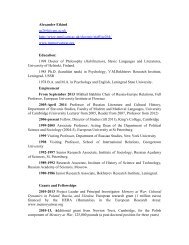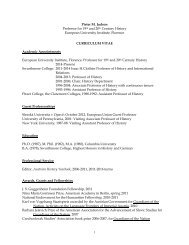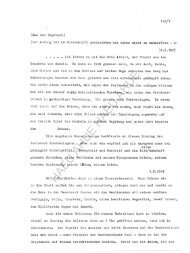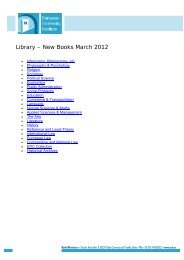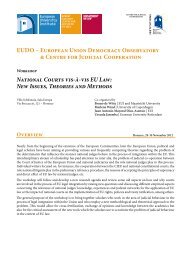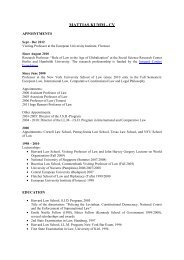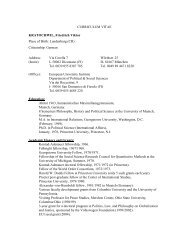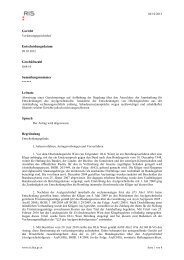The History, Interpretation and Underlying Principles of Section
The History, Interpretation and Underlying Principles of Section
The History, Interpretation and Underlying Principles of Section
Create successful ePaper yourself
Turn your PDF publications into a flip-book with our unique Google optimized e-Paper software.
EUI-RSCAS/Competition 2007/Proceedings 33/42<br />
to treble damages, <strong>and</strong> given that lay juries decide questions <strong>of</strong> intent <strong>and</strong> that even a threat to<br />
sue may (due to the costs <strong>of</strong> litigation) may have a deterrence effect, the pressure for a narrow<br />
approach to predatory pricing may be strong. 180 From that perspective, the current<br />
enforcement environment in the EU differs significantly. Despite efforts to strengthen private<br />
enforcement, incidents <strong>of</strong> independent private enforcement are still comparatively rare. Public<br />
enforcement dominates. Where private enforcement takes place, no juries are involved, <strong>and</strong><br />
courts do not impose treble damages. Furthermore, a losing party will ultimately bear the<br />
costs <strong>of</strong> litigation, which diminishes the incentives to sue.<br />
While the difference in enforcement conditions goes some way toward explaining the<br />
difference between the EU <strong>and</strong> the US, it may not exhaust the reasons for diverging attitudes<br />
in the field <strong>of</strong> predatory pricing. <strong>The</strong> fact that the US requires pro<strong>of</strong> <strong>of</strong> actual or likely<br />
consumer harm whereas under EU law a showing <strong>of</strong> intent to eliminate a competitor will<br />
suffice is insufficiently explained by different needs in the US <strong>and</strong> in the EU to lower or raise<br />
the hurdles faced by potential plaintiffs. More fundamentally, it reveals different views <strong>of</strong> the<br />
structure <strong>and</strong> purpose <strong>of</strong> competition law. <strong>The</strong> US predatory pricing test faithfully reflects the<br />
view that the protection <strong>of</strong> consumer welfare is the ultimate <strong>and</strong> only relevant goal. Where a<br />
competitor is harmed by below-cost pricing by a dominant firm (<strong>and</strong> even if driven by<br />
anticompetitive intent) but the objective likelihood <strong>of</strong> recoupment <strong>and</strong> thus <strong>of</strong> consumer harm<br />
appears to be small, the competitor will enjoy no protection. 181 Community competition law<br />
takes a fundamentally different stance. It focuses not on the protection <strong>of</strong> a particular market<br />
outcome, but on the protection <strong>of</strong> the competitive process <strong>and</strong> <strong>of</strong> the competitors who<br />
participate in it. <strong>The</strong> latter are protected against exclusions that result not from competition on<br />
the merits, but from the unilateral exercise <strong>of</strong> power by a dominant firm. 182 Such protection <strong>of</strong><br />
competitors is not in opposition to protection <strong>of</strong> competition, as the much-cited slogan<br />
“protecting competitors versus protecting competition” suggests. But it reflects the<br />
underst<strong>and</strong>ing that competition is a process that results from the exercise <strong>of</strong> individual rights.<br />
Competitors, in their exercise <strong>of</strong> economic freedom, engage in a process in which they may<br />
lose <strong>and</strong> possibly perish. However, competition law will ensure that the fate <strong>of</strong> each<br />
competitor will depend on skill, business acumen <strong>and</strong> luck, <strong>and</strong> not on the exclusionary<br />
exercise <strong>of</strong> market power by a dominant firm. 183 <strong>The</strong> efficiency effects <strong>of</strong> such a concept <strong>of</strong><br />
competition law will sometimes differ from the effects <strong>of</strong> a concept that looks directly to<br />
180 Kovacic, supra note 8, at 53-54.<br />
181 See Weyerhaeuser, supra note 155, at 1077 (citing Brooke Group, supra note 145, at 224). According to the<br />
Supreme Court, without successful recoupment, “predatory pricing produces lower aggregate prices in the<br />
market, <strong>and</strong> consumer welfare is enhanced”.<br />
182 See Commission Decision 97/624/EC, 1997 OJ L258/1 – Irish Sugar plc, para. 34: “<strong>The</strong> maintenance <strong>of</strong> a<br />
system <strong>of</strong> effective competition does, however, require that competition from undertakings … be protected<br />
against behaviour by the dominant undertaking designed to exclude them from the market not by virtue <strong>of</strong><br />
greater efficiency or superior performance but by an abuse <strong>of</strong> market power.” See also Eilmansberger, supra<br />
note 21, at 133, who explains that the purpose <strong>of</strong> Article 82 is “to ensure that the exercise <strong>of</strong> market power does<br />
not impair competitors’ possibilities to succeed or prevail on the market on the basis <strong>of</strong> superior business<br />
performance”.<br />
183 See Mestmäcker, “Die Interdependenz von Recht und Ökonomie in der Wettbewerbspolitik”, in<br />
Monopolkommission, ed., Zukunftsperspektiven der Wettbewerbspolitik, Nomos, 2005, pp. 19 <strong>and</strong> 34-35.<br />
Schweitzer, “<strong>The</strong> <strong>History</strong>, <strong>Interpretation</strong> <strong>and</strong> <strong>Underlying</strong> <strong>Principles</strong> <strong>of</strong> <strong>Section</strong> 2 Sherman Act <strong>and</strong> Article 82 EC”, in Ehlermann<br />
<strong>and</strong> Marquis, eds., European Competition Law Annual 2007: A Reformed Approach to Article 82 EC, forthcoming 2008.




